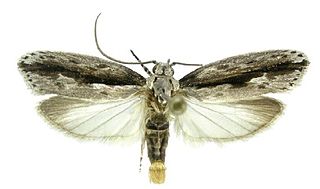Pyramidobela agyrtodes is a moth in the family Oecophoridae. It is found from in southern North America from extreme western Texas to southern Chihuahua and Nuevo León.
Pyramidobela ochrolepra is a moth in the family Oecophoridae. It is found in Mexico.
Ethmia apicipunctella is a moth in the family Depressariidae. It is found in North America from southern Texas and Nuevo León to eastern Arizona and adjoining areas of Mexico. In the north, the range extends into Colorado and southern Wyoming.
Ethmia mansita is a moth in the family Depressariidae. It is found in central Mexico.
Ethmia semitenebrella is a moth in the family Depressariidae. It is found in North America from Colorado, Utah, New Mexico and Nuevo León in Mexico to Arizona and southern and eastern California.
Ethmia davisella is a moth in the family Depressariidae. It is found in north-eastern Mexico.
Ethmia subsimilis is a moth in the family Depressariidae. It is found in Jamaica and Cuba and has also been recorded from Florida in the United States.
Ethmia wellingi is a moth in the family Depressariidae. It is found in Mexico. Records from Costa Rica refer to Ethmia stephenrumseyi.
Ethmia confusella is a moth in the family Depressariidae. It is found from the Florida Keys and Bahamas, through the Greater Antilles to the Yucatan Peninsula, and through the Lesser Antilles to Trinidad.

Ethmia nigritaenia is a moth in the family Depressariidae. It is found from southern Mexico, Guatemala and Honduras to north-western Costa Rica.
Ethmia subnigritaenia is a moth in the family Depressariidae. It is found in Mexico.

Ethmia catapeltica is a moth in the family Depressariidae. It is widespread in Central and northern South America, from southern Mexico to Bolivia.
Ethmia semiombra is a moth in the family Depressariidae. It is found in Texas and Mexico.
Ethmia conglobata is a moth in the family Depressariidae. It is found in Colombia.
Ethmia gigantea is a moth in the family Depressariidae. It is found in Mexico.
Ethmia albicostella is a moth in the family Depressariidae. It is a widespread species in the Rocky Mountains and Sierra Madre Occidental of Mexico, ranging from southern Manitoba, Saskatchewan, and Montana through the southern Rocky Mountain states at moderately high elevations and mountains of western Mexico at least south to Durango.
Ethmia mirusella is a moth in the family Depressariidae. It is found in the United States from Kansas and Oklahoma to central and western Texas.
Ethmia cordia is a moth in the family Depressariidae. It is found in eastern Mexico.
Ethmia oterosella is a moth in the family Depressariidae. It is found in Cuba.
Ethmia angustalatella is a moth in the family Depressariidae. It is found in north-eastern Mexico and Texas.

